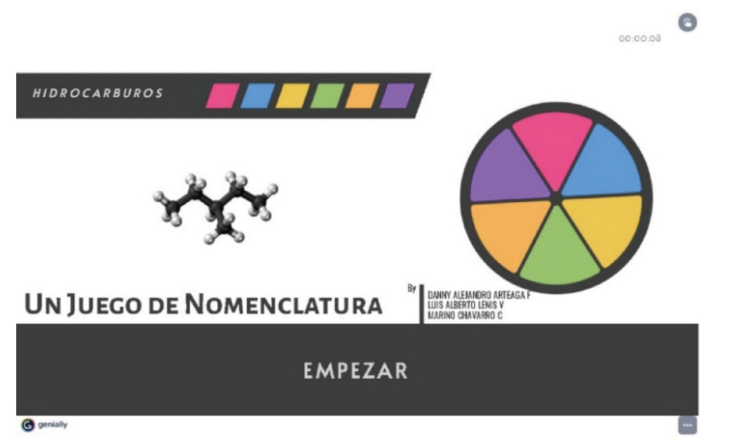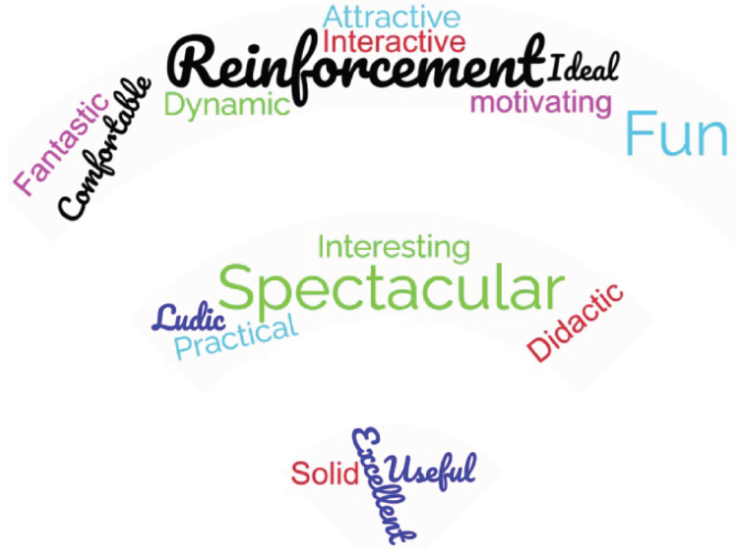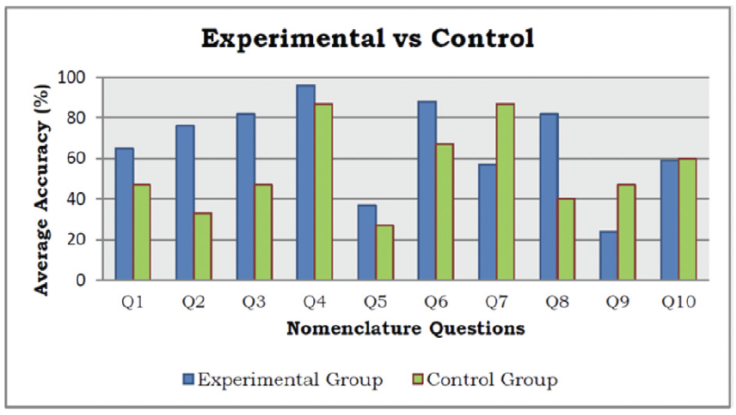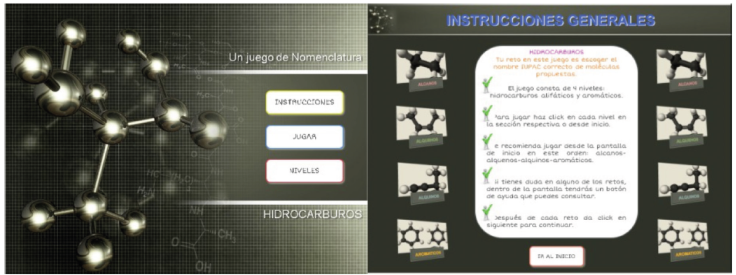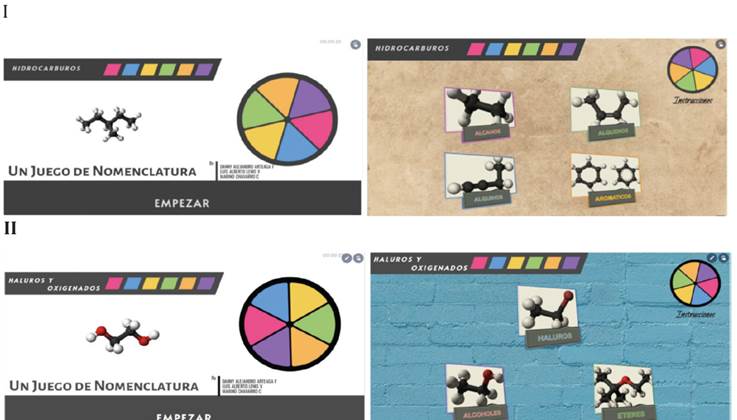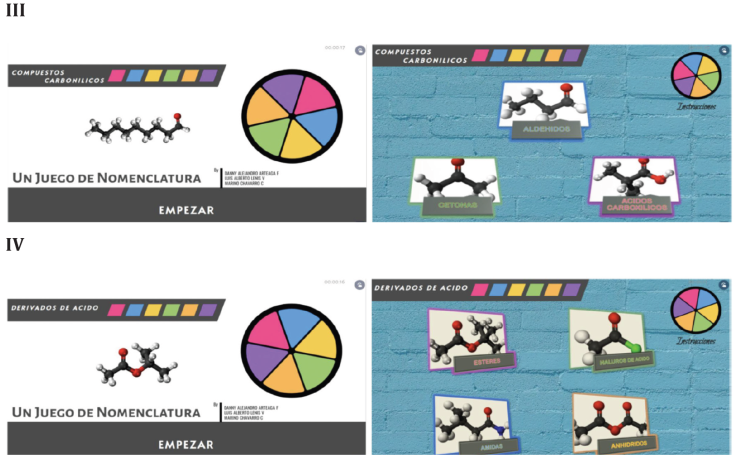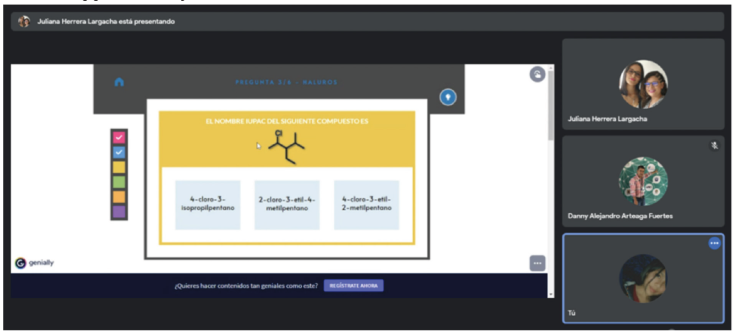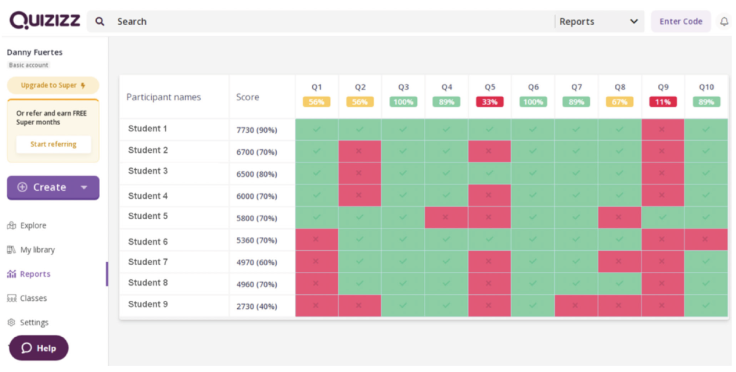Introduction
Along the years, traditional education methods had led to the development of learning process in all science fields, and chemistry is no exception. Its surrounding has centered mostly on communicating content from teacher (issuer) to students (receiver) having as a limit the use of tools to explain information mostly on a white board, chalkboard, conferences or regular classes (Torres S., 2010). For the new generations of “digitally born” students, the exclusive use of those teaching methods does not help to promote self-learning environments or engaging to topics. Capture their attention and awaken learning motivations is one of the greatest challenges today’s teachers have (Hernández Garces et al., 2015; Luis et al., 2013). Fortunately, with the advances of information technologies TIC’s (Daza Pérez et al., 2009; Hofer et al., 2021; Martínez-Argüello et al., 2018; Tikva and Tambouris, 2021) changes had happened on teaching styles towards active learning’s and dynamic styles, efficiency and engaging (Cipagauta et al., 2021; Hernandez et al., 2016; Herrera Beltrán and Mosquera Suarez, 2021). Including this new methods plus learning patterns of students had driven research to find ways of for students to own their knowledge on any science field (Allan et al., 2013; Watson, 2001). Specifically, on chemistry, which many times shows itself as abstract, difficult, monotonous, detach, and far from professional or real life experiences (Gutierrez Mosquera and Barajas Perea, 2019), that is why it becomes necessary to bring modern like gaming (Buendía-Atencio et al., 2022; Jääskä and Aaltonen, 2022; NOURI and Rahimi Meroei, 2021; Porto et al., 2020; Sousa Lima et al., 2019), class Ludic (Maila-Álvarez et al., 2020; Zaragoza Ramos et al., 2016); flipped classroom (Nappa et al., 2021; Peralta-Benítez et al., 2021), video-based learning (Hernández et al., 2014; Londero Balza, 2014); digital content usage (Figueiredo et al., 2016; Liu et al., 2022; Thibaut and Schroeder, 2022), and interactive platforms (Athavan Alias Anand, 2021; Christiansen, 2021; Dabke et al., 2022), that allowed revitalize the learning of concepts as well as to heal the wrong and “a priori” concept of chemistry as a difficult science.
During the year 2000, when our world went through the health emergency because of Covid-19, strategies on education based on Information Technologies became a must and caused that all learning processes migrate to virtual means generating a change in class dynamics (Abraham and Queijeiro, 2020; Gabriela Caroline Kroth et al., 2022; Lapitan et al., 2021; Zendler and Greiner, 2020). Because of that, teaching IUPAC nomenclature was a big challenge, as it is one of the main subjects to learn for students of organic chemistry.
In general, this topic requires learning and memorizing specific rules, answering repetitive and un-attractive workshops that, added to pandemic confinement, caused the learning to be much more tiresome and stressful. Fortunately, along the last years, technologic advances have develop alternate methodologies on innovative education, that besides complementing traditional teaching strategies ease-up educational dynamics helping to overcome weak spots on learning subjects (Buendía-Atencio et al., 2022; Gutierrez Mosquera and Barajas Perea, 2019; Porto et al., 2020; Valdez et al., 2011). Our purpose aims to consolidate an active learning method, where the roles of the education system are inverted having the teacher as a facilitator while students are the main characters of their own learning. Reviewing previous works, it is noticeable that for XXI century students, one most effective and engaging way for them to learn is to include games and interactive tools, we plan for a mixed pedagogy, based on nomenclature content exploration, design on Genially web platform (Abdul Rahim, 2022; de Souza and Kasseboehmer, 2022); and working collaboratively around it. Also, planned dynamic and produced material will be accessible to be reused generating a great advantage for class process (Abdul Rahim, 2022; Allan et al., 2013; Athavan Alias Anand, 2021; Christiansen, 2021; Dabke et al., 2022). On one hand, it allows students to go at their own pace, and to participate in collaborative work; being this, quite an important element for the learning development by virtue of promoting the understanding of topics through leadership, debates and talks, offers competitive or comradeship relations were student have to be up to level and/or helping each other (Peralta-Benítez et al., 2021; Zendler and Greiner, 2020). Present research, carried out during Covid-19 confinement, emerged as an efficient alternative to teach organic nomenclature to college students from different programs (Science and Engineering) of Cauca University. Combining team-work and ludic-class as methods of active learning methods generates a unique and fun environment to engage into knowledge appropriation.
Methods
This innovative educational proposal was carried out at University of Cauca for a period of 12 months (2021, I and II semester). It was developed with engineering and science students having organic chemistry assigned class under the fundamental cycle. It was put into practice on a three (3) time-frame stages: Planning, implementation, and validation. Planning and design had within diverse elements which were developed and adjusted on three consecutive stages: I. Operational and disciplinary parameter definition. II. Design and build-up of interactive platforms; III. Review and adjustment of content and format. During the second stage each of gaming and activities were applied as playful strategies of teaching-learning. It was made on a building-up manner towards team-work and under previously planned phases: I. Approaching to students II. Usage of interactive game design tools. III. Competence and goals achievement evaluation. During validating stage, a by-step process was also done as follow: I. Operative evaluation. II. Disciplinary evaluation; III. Results analysis and treatment. All information was collected through directed survey on Google forms and predefine testing concepts.
Discussion
Walking through this design education strategy, we noticed that during compliance of its stages, results where interesting in these aspects: academic and classroom research. Evidence was analyzed on each stage allowing us to evaluate the effect of the project over the process of learning organic nomenclature.
Stage I. Planning. Design of Academic Strategies
About elaborating the used materials, we included key parameters directly related to IUPAC nomenclature rules to all organic chemistry functional groups, which were organized considering academic and operational parameters.
PowerPoint Prototype
PowerPoint was the first preliminary platform used to establish the structure of interactive tools as part of our research material. Its service was to generate a friendly environment as well as fun and easy tool to play and explore with; that way, students would use autonomous learning on their learning activities. Proposed schedule consisted of six (6) sections according to a consecutive order (Figure 1).
It was proposed the display of a main menu with the general game instructions, by-levels of thematic, and with a “play” button sending player automatically to first level. Within general instructions are the order of levels to follow to be able to move inside the platform (SI: Figure S1). In a trial level, developed tools fulfilled with our purpose, however, PowerPoint presented few limitations causing prototypes being not too functional as for inconveniences like students can sneak into answers previously, skip levels or handle written information. Therefore, we moved our concept of to another platform: Genial.ly, which is a free access online tool.
Genial.lyprototype
Using the previously design structure on PowerPoint and a variety of elements from Genial.ly, we design interactive platforms as new pedagogic material aiming to cover needs, weaknesses, and strengths from students (SI: Table S1, Links and Figures S2-3). Changes made included featuring an initial game presentation screen which highlight the name of the activity: “Nomenclature game”. The screen also has the names of the researchers, names of by- topic groups, a start-button; and as a new element, a timer to measure activity’s time progress (Figure 2).
When clicking on the “start button” program will take students to a main menu of the game where instructions and all levels from organic compound types (Figure 3). Changes applied are about level notifications, e.g. for hydrocarbons, exploring should begin with alkanes. If the student wishes to start with another level without following the correct order, the game won’t allow it. Like this, the game avoids the possibility for the student to omit a particular level aiming to strengthen the process build-up of concepts learning.
When starting the appropriate level, another instructive menu opens with specifications on such organic functional groups using two buttons: begin and play directed to main menu’s and to first game’s exercise (Figure 4). Instructions were kept from previous versions (PowerPoint) and proposed exercises were classified and displayed on screen according to complexity level (colored scale). Screen also include a start and help button. For the student to be able to remember forgotten rules, he/she will be able to press the help button which will bring them back to specific instructions about each organic functional group. It also displays three multiple choice answers.
Including an explanation to each correct answer was one of the substantial changes offered on Genial.ly version, because it was observed the need from the student to know the fundaments of its correct or incorrect choice. Same way, when choosing a correct answer, it is recorded an approval checkmark on control boxes (colored scale) which allows knowing the student’s advancement on the platform (Figure 5).
Table 1 shows the levels and functional groups worked inside as well as the number of strategies and version done during present research. Prototypes on Genial.ly were made on Spanish language as students are Spanish speakers.
Table 1 Thematic and design of educational strategies with free access platforms.
| Estrategy | Level | Functional groups | Tool | No. | ||
|---|---|---|---|---|---|---|
| Power Point | Genial.ly | |||||
| I | Hydrocarbons | Alkanes | Alkenes | 1 | 2 | 3 |
| Alkynes | Aromatics | |||||
| II | Halides - Oxygenated | Alcohols | Ethers | 1 | 2 | 3 |
| Alkyl halides | Aryl halides | |||||
| III | Carbonilic Compounds | Aldehydes | Ketones | 1 | 2 | 3 |
| Carboxilic | Acids | |||||
| IV | Acid Derivatives | Esters | Acid Halides | 1 | 2 | 3 |
| Amides | Anhydrides | |||||
Stage II. Strategy Implementation
Executing this stage was building-up according to in-course subjects and class topics, specifics on study groups and under a planning format as follow.
Diagnostic Tools
Firstly, an initial survey was done allowing to explore some general aspects about participating students. From them, 58 were women and 39 men. The age range was approximately 18 to 19 years old. For such age groups, mostly women predominated except in the age groups of 20 years where men were much more. Related to academic background before enrolling in college, it was observed that 78.6% of students come from middle public schools and 21.4% from private schools. About the question if students receive full courses about organic chemistry contents in school, 70 from public schools and 17 from private schools answered they indeed coursed the class. Finally, 10 of the public students stated that they had never studied this subject during the school year (SI: Figures S4-5).
Academic Strategies
This educational proposal was carried out with students attending different academic programs, for a total of 97 students divided into 2 big groups (A and B) equally participating in the activity (Table 2).
Table 2 Relation between teamwork groups and academic programs.
| Group | Experimental Groups* | Total | |||||
|---|---|---|---|---|---|---|---|
| Bio | Chem | AE | PE | EE | BM | ||
| A | 14 | - | 12 | 13 | 5 | 2 | 46 |
| B | 5 | 11 | - | 18 | 17 | - | 51 |
* Academic programs: Bio: Biology; Chem: Chemistry; AE: Agro-industrial Engineering; PE: Physical Engineering; EE: Environmental Engineering; BM: Bachelor of Mathematics.
Work sessions from design content (Table 1) were carried out remotely (virtual class) due to world health emergency. It happened on over-time class schedule through a collaborative class work for students to explore tools, working in couples on virtual meeting through Google Meet. Each group had a total of 4 sessions (60 to 90 min.) subjected to connectivity, work pace and topic studied.
Stage III. Validation
To validate efficiency of the strategy, acquired competences and operation of interactive platforms, surveys and a test (multiple selection) were implemented. By session/ by work group a survey was made to analyze the level of agreement from participants through affirmations on 3 significant aspects: 1. Functionality and graphic interface; 2. Content relevance; and 3. Student’s perception (Tables 3-5).
Table 3 Evaluating affirmations for interactive platform: functionality and interface.
| Question | |
|---|---|
| 1 | Do you consider the work environment about the ludic tool was always pleasant? |
| 2 | Did you find incompatibilities when using the tool making it hard to handle? |
| 3 | Instructions and illustrations to access game and functionality were clear? |
| 4 | The played tool allowed to display functions in an adequate manner filling your expectations? |
| 5 | Do you believe game tools and buttons were easy to handle? |
| 6 | Are you against the graphic designs of the game? |
| 7 | When exploring the tool, you found all functions and links well integrated? |
| 8 | Was the language used difficult to understand to interact fluently with the game tools? |
Table 4 Affirmations to evaluate interactive platform: content relevance.
| Question | |
|---|---|
| 1 | The order in which the levels are presented facilitates the learning of nomenclature rules. |
| 2 | Presented content is pertinent to support the learning process of organic nomenclature. |
| 3 | Implemented games as ludic strategies offer quality in its content presentation. |
| 4 | You had previous experiences to reinforce and learning of chemistry content. |
| 5 | Information, text, graphics, and rules displayed when hitting buttons are pertinent. |
| 6 | Content and exercise offered are adjusted accordingly to required levels for college students. |
| 7 | Proposed exercises to move-up to levels are relevant and were appropriately chosen. |
| 8 | Comments when failing or achieving exercise or levels are clear and concise. |
Table 5 Affirmation/ denials to evaluate interactive platform: student’s perception.
| Question | |
|---|---|
| 1 | According to experience, you highly value the level of satisfaction to help your learning process. |
| 2 | According to your perception and achieved results, it motivating to work with this tool. |
| 3 | The use of nomenclature games was vital to full fill your learning goals. |
| 4 | Consider the game tool was nice allowing to create personal learning environments. |
| 5 | You would recommend to other people the use of applied games as they are attractive. |
| 6 | To reinforce organic nomenclature learning you would prefer the use of other tools. |
| 7 | Developed games were tired-some and frustrating. |
| 8 | If needed, you would repeat the use of the game as a learning tool. |
According to worked session and group distribution (A and B), a total of 8 surveys were recorded that helped to classify the information according to the topic and the results were analyzed by interest and comparison groups.
Hydrocarbons nomenclature was the first studied topic in our educational strategy, therefore, the analysis followed in this topic will be very detailed. Table 3 shows affirmation/ negation used in surveys to evaluate tools feasibility on first aspect: functionality and graphic interface.
Level of agreement of survey respondents was determined using a Likert measuring method (Likert, 1932). Values represented on figures follow this convention: 5. Totally agree (blue) 4. Agree (red) 3. Indifferent (yellow) 2. Disagree (green) 1. Totally disagree (orange). Consolidated results for groups A and B (Figure 6) showed the following percentages of affirmations (Q1, Q3, Q4, Q5, Q7) between 60.9 and 89.1 % manifested to be totally agree. Negative phrases (Q2, Q6, Q8), 58.7 and 76.5 % responded: totally disagree. Analysis of this tendencies and understanding the intention of each question, allows us to conclude on a high level of acceptance towards the functionality of hydrocarbons platform.
To evaluate the content pertinence displayed on the platform of hydrocarbons: “nomenclature game”, it was also analyzed some acceptance and tendencies against 8 affirmations (Table 4).
As in the previous aspect, both groups maintained a high acceptance of the previous statements (Figure 7). In all the questions, except Q4, answers totally agree (49.0-86.3%) and agree (11.8-43.1%).
These percentages allow noticing that structure and content were acceptable. The variability of Q4 responses is shown as a special case. When analyzing preferences, it was visible that majority of students had never used or explored interactive tools to reinforce learning on any chemistry content. This result motivated even more our research team to keep on innovating this tool.
For the last aspect of the survey, the behavior of the students and their perspective on the development of the activity were determined. To do this, the level of approval through 8 questions/denials (Table 5).
Figure 8 shows the results for both groups responding to a high level of acceptance. 91.3 to 100% for affirmations Q1 to Q5 and Q8, and high levels of dislike (73.9 to 86.3%) over Q6, Q7. Values indicate that students felt pleasant with the activity with a high level of satisfaction as their learning process.
General analysis and treatment of data for other work sessions (Alkyl Halides, Anhydrides, Oxygenated Products, Carbonilic Compounds, Acid Derivates), showed that from three aspects valued, most students answer positively. Tendencies in answers on each section showed high levels of agreement on affirmations, and high levels of disagreement on negative questions (SI: Figures S7-11). This allow us to estimate that our proposal was versatile, didactic, attractive and with needed elements to become into a complementary tool to strengthen teachings and learning on IUPAC nomenclature on organic compounds for college students.
In the same way, it was found interesting facts from open-ended written questions. In the last survey (acid derivates session), we offered this type of questions looking for more elaborated answers and analysis of the study groups. From our inquiry, we high-point two questions: 13. According to activities over the semester, what positive elements does this academic initiative have? and 14. Would you like strategies like this to be implemented as ways of teaching or evaluation? Why? The result analysis suggests that students embraced platforms and pedagogic strategies like collaborative work with thrill. Each recorded quote from the educational tool enhanced and supports our initiative (SI: Tables S2-3). We allowed ourselves to share some of them (Figure 9).
Other elements were considered to evaluate the efficiency of the activity as the follow-up of the acquired skills. At the end of each of the 4 work sessions, an evaluation test about organic nomenclature was applied. Sixty-four (64) volunteer students agreed to be evaluated under a ludic environment. Forty-nine (49) of them, from an experimental group and 15 from a control who never had access to such tools. This allowed to evaluate existing differences among learning through-out the interactive proposal against regular traditional class approach.
The test was done through multiple choice answer using Quizziz as ludic platform with a total of 10 questions about IUPAC nomenclature connecting organic structures to representative functional groups (SI: Table S4, Figure S12). Thirty-five (35) students from experimental group approved the test, i.e., 71.4% of the total number of evaluated students, which were classified in four groups G1 to G4 according to their effectives in their answers (Figure 10, left). From first to fourth groups, effectiveness percentages vary from 60 to 90%, highlighting G3 with 13 students with a 70% average. Compared to the control group only 6% students had 60-90% correct answers from 40% of students evaluated. Percentages show that most evaluated students from groups G11 and G14 failed the test, especially G11 with only 4 students reaching only 50% of average (Figure 10, right).
If we compare results, we notice that there are significant differences in learning organic nomenclature among students using traditional learning ways. Such tendencies were confirmed when comparing effectiveness through single answering (question by question) on both team works (Figure 11).
Most of the related questions from Q1 to Q10 experimental groups achieve higher positive percentages with a difference in a 10 to 40%. It could mean that the number of correct answers were higher for students using the interactive tool during class semester, which confirms that applying complementary tools allows to strengthen such class subjects. However, there were three questions with unsuspected results about partial outcome, we can point out that for Q5 (SI: Table S4) it is presumable that response was given in a quick answer, probably due to students forgetting the main characteristic: selection and numbering of the longest chain of the hydrocarbon, which defines the location of the main functional group, which is the case of carbon number 2, i.e., the alcohol. Same behavior happened to question 7, according to structure, both substituents are on position no.1, and they omitted the priority in the alphabetical order, considering that both functionalities have the same hierarchy at the time of naming. We should mention that there was a time frame to answer. Time could be extended until fully answered. Additionally, it could mean that the highest percentage on this question 87%, was done by the control group, which could be linked to a methodology strategy applied by the in-class teacher on this matter. Regarding the results in Q9, they are the lowest expected for both groups: experimental 24% and control 47%, we believe that the question could have caused confusion due to the infrequent use of this type of structures. It should be considered the longest hydrocarbon chain that contains the largest number of functional groups within.
Conclusion
This work presents the achieved goals about the implementation of a pedagogic methodology supported on collaborative strategies and class ludic using a prototype of didactic game design on Genial.ly platform to complement organic nomenclature learning with college students. Result analysis and reached goals throughout development, show that our innovative educational proposal let to contribute fill expectative over study groups from operational and disciplinary component as it is a non-traditional educational strategy that grants motivation, stimulates, and teaches our students in a more fun ways making them protagonist of their own learning. Eighty (80) to 90% of acceptance about handling, content, and perception about the applicability of such tools, caused a higher academic performance on evaluative testing for most of students (71.4%). It permits to foresee these as valuable methodologies building to promote new proposals on innovative education for teaching and learning advanced content on chemistry fields. Also, we have demonstrated that ludic resources and its applicability improved academic performance on organic nomenclature. We believe that they were pertinent and with high relevance, specially during health emergency where young students required alternate learning fun processes to mitigate stress caused by frequent lock-down periods. Therefore awaking their interest in learning topics from different areas. It is important to highlight that these tools are not planned to substitute other teaching methods, being active learning tools are to support and enhance learning-teaching process.











 nueva página del texto (beta)
nueva página del texto (beta)


